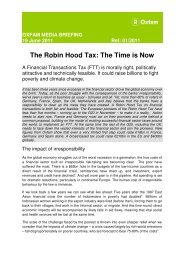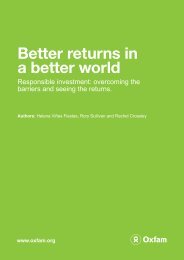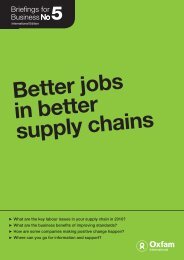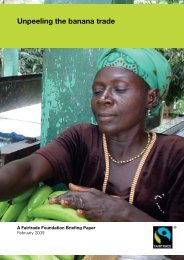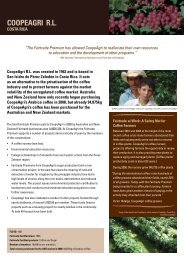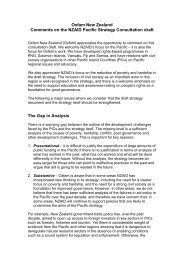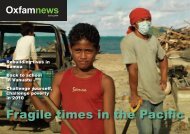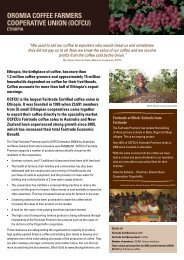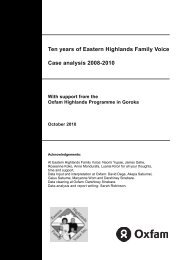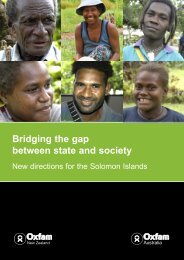Getting it Right from the Start - Oxfam New Zealand
Getting it Right from the Start - Oxfam New Zealand
Getting it Right from the Start - Oxfam New Zealand
You also want an ePaper? Increase the reach of your titles
YUMPU automatically turns print PDFs into web optimized ePapers that Google loves.
2 Understand <strong>the</strong> conflict dynamicsHuman<strong>it</strong>arian and development efforts in South Sudan must be basedon a realistic, nuanced and well-informed understanding of <strong>the</strong> evolvingcontext. This includes an understanding of <strong>the</strong> drivers and dynamics ofconflict, and an appreciation of <strong>the</strong> importance of <strong>the</strong> link betweensecur<strong>it</strong>y and development.In South Sudan, drivers of conflict vary across <strong>the</strong> country and overtime, but include lack of employment opportun<strong>it</strong>ies for youth 8 ;compet<strong>it</strong>ion over natural resources; cattle-raiding; land disputes(including „land grabbing‟ by powerful individuals and large-scale landacquis<strong>it</strong>ion by private investors 9 ); ongoing Sudan/South Sudantensions; abuses by armed groups; conflict between <strong>the</strong> SPLA andrebel groups; and spill-over <strong>from</strong> neighbouring (regional) conflicts. Thecorrosive impact of <strong>the</strong>se conflict drivers is exacerbated by <strong>the</strong> fact that<strong>the</strong> role trad<strong>it</strong>ionally played by tribal chiefs in non-violent conflictresolution has been eroded by displacement, urbanisation and <strong>the</strong>proliferation of small arms.A range of tools have been developed for <strong>the</strong> purpose of assistinghuman<strong>it</strong>arian and development actors to analyse and address <strong>the</strong>drivers and dynamics of conflict. But evaluations have found that inSouth Sudan, such tools are not being used to <strong>the</strong>ir full potential. Lastyear‟s multi-donor evaluation, Aiding <strong>the</strong> Peace, found that very fewdonors had „explic<strong>it</strong>ly and regularly referred to conflict analyses inprogramme planning‟, 10 and <strong>the</strong> government‟s recent „Survey forMon<strong>it</strong>oring <strong>the</strong> Implementation of <strong>the</strong> Fragile States Principles‟ foundthat a number of donors expressed doubts as to whe<strong>the</strong>r „we fullyunderstand <strong>the</strong> current context‟. 11 The use of gender-analysis inunderstanding <strong>the</strong> causes and drivers of conflict is even less likely.A lack of attention to <strong>the</strong> drivers and dynamics of conflict has a numberof possible implications: a premature shift to post-conflict recovery to<strong>the</strong> detriment of basic service delivery; supply-driven, short-termhuman<strong>it</strong>arian aid that fails to build commun<strong>it</strong>y resilience and can in factexacerbate vulnerabil<strong>it</strong>y; poorly-designed programs that address <strong>the</strong>symptoms but not <strong>the</strong> underlying causes of conflict; a focus oneconomic development w<strong>it</strong>hout due attention to related pol<strong>it</strong>ical andsecur<strong>it</strong>y prior<strong>it</strong>ies; and inadequate attention to regional secur<strong>it</strong>y threatssuch as <strong>the</strong> LRA or to developing <strong>the</strong> professionalism of <strong>the</strong> state‟s ownsecur<strong>it</strong>y forces. 12In add<strong>it</strong>ion to <strong>the</strong> under-utilisation of conflict analysis tools, <strong>the</strong>re hasalso been an under-appreciation of <strong>the</strong> link between secur<strong>it</strong>y anddevelopment. Insecur<strong>it</strong>y disrupts cultivation, lim<strong>it</strong>s movement and trade,restricts access to markets, schools and healthcare and exacerbatesvulnerabil<strong>it</strong>ies – w<strong>it</strong>h women and children almost alwaysdisproportionately affected. One example of this is in <strong>the</strong> LRA affectedareas of Western Equatoria. According to OCHA, in 2010 LRA attacksaccounted for only a minimal number of civilian casualties, but 20 percent of displacement in South Sudan during that year, w<strong>it</strong>h 45,0009



